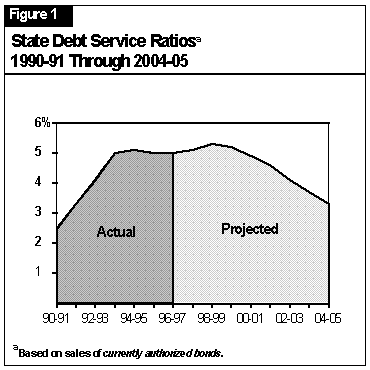
This section of the ballot pamphlet provides an overview of the state's current bond debt. It also provides a discussion of the impact the bond measures on this ballot, if approved, would have on this debt level.
Background
What Is Bond Financing? Bond financing is a type of long-term borrowing used to raise money for specific projects. The state gets money by selling bonds to investors. The state must pay back the amount of the bonds along with interest.
The money raised from bonds primarily funds large capital outlay projects, such as prisons, schools, and colleges. The state uses bond financing mainly because these facilities are used for many years and their large dollar costs are difficult to pay for all at once.
General Fund Bond Debt. Most of the bonds the state issues are general obligation bonds. The General Fund makes debt payments on about three-fourths of these bonds. The remaining general obligation bonds (such as veterans' housing bonds) are self-supporting and, therefore, do not require General Fund support. The money in the General Fund comes primarily from state personal and corporate income taxes and sales taxes. General obligation bonds must be approved by the voters, and are placed on the ballot by legislative action or by initiative.
The state also issues bonds known as lease-payment bonds. These bonds do not requirevoter approval. The state has used these bonds to fund capital outlay projects in higher education, to construct prisons, and to build state offices. The General Fund also makes debt payments on these bonds.
What Are the Direct Costs of Using Bonds? The state's cost for using bonds depends primarily on the interest rate that is paid on the bonds and the number of years over which they are paid off. Most general obligation bonds are paid off over a period of 20 to 30 years. Assuming an interest rate of 6 percent, the cost of paying off bonds over 25 years is about $1.78 for each dollar borrowed--$1 for the dollar borrowed and 78 cents for the interest. These payments, however, are spread over the entire period, so the cost after adjusting for inflation is less. This is because future payments are made with cheaper dollars. Assuming a 3 percent future annual inflation rate, the cost of paying off the bonds in today's dollars would be about $1.30 for each $1 borrowed.
The State's Current Debt Situation
The Amount of State Debt. As of July 1, 1996, the state had about $20.2 billion of General Fund bond debt--$14.3 billion of general obligation bonds and $5.9 billion of lease-payment bonds. Also, about $9 billion of authorized bonds had not been sold because the projects to be funded by the bonds had not been undertaken.
Debt Payments. We estimate that payments on the state's General Fund bond debt will be around $2.4 billion during the 1996-97 fiscal year. As currently authorized bonds are sold, bond debt payments will increase to about $2.9 billion in 1999-00 and decline thereafter.
The level of debt payments expressed as a percentage of state General Fund revenues is referred to as the state's ''debt ratio." Figure 1 shows actual and projected debt ratios from 1990-91 through 2004-05. The figure shows that as currently authorized bonds are sold, the state's debt ratio will increase to 5.3 percent in 1998-99 and decline thereafter.

Bond Measures Proposed for the Ballot
There are three general obligation bond measures on this ballot that total $2.1 billion:
If these bond measures are approved, we estimate that the state's bond debt payments would remain at about $2.9 billion through 2001-02 and the state's General Fund bond debt would total $21.3 billion (after accounting for the sale of some authorized bonds and the retirement of some debt). The debt ratio would remain at the projected peak of 5.3 percent through 1999-00 and decline thereafter. Voter approval of additional bonds at future elections or legislative authorization of additional lease-payment bonds would increase the state's debt.